- Article
- Industry, Business, Technology
Incorporating Diversity as a Core Business Value: Dentsu Inc.
September 10, 2015
The focus of Dentsu’s CSR activities is on human rights. As Japan’s biggest advertising agency, it has developed great sensitivity to and amassed a wealth of experience regarding human rights issues while helping client companies formulate and disseminate their message to consumers.
In general, the scope of most corporate human rights initiatives is limited to providing training and workshops for employees or setting up systems to answer employee queries. Dentsu goes much further, addressing a broad array of issues in many different ways. One example is its longstanding sponsorship of two human rights contests: the first calls on employees to submit human rights slogans, for which there were there 9,866 entries in 2013; the second is for the design of human rights posters, which has evolved into a collaborative project with several art universities.
Dentsu Human Rights Slogans and Posters (Fiscal 2012)
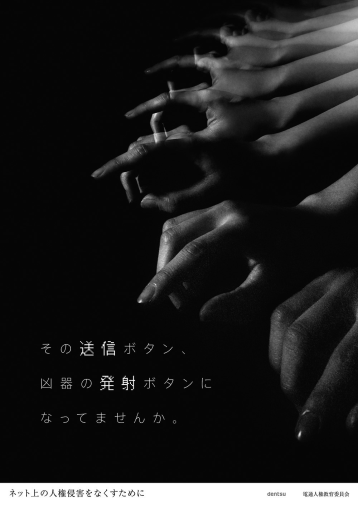
Eliminating discriminatory, hate-inspired remarks on the Internet
Slogan: When is a “ Send ” button like a n “Attack” button?
Meaning: Encourage people to think twice before making condemning online comments .
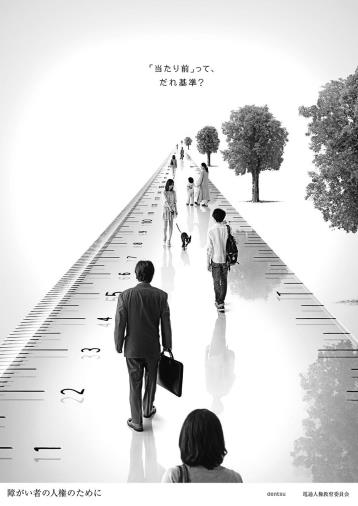
Increasing awareness of people with disabilities
Slogan: Who are you excluding when you say, “Anyone can do it”?
Meaning: Help people realize that just because they can do something easily does not mean that “everyone” can.
Dentsu Human Rights Art Project Poster (Fiscal 2012)
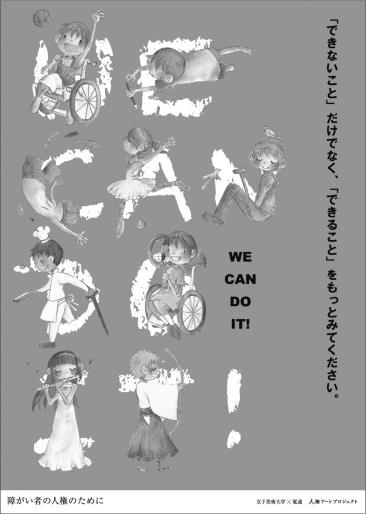
Promoting Cross-Sector Information Sharing
Dentsu also has what it calls Labs where employees from different departments can come together to work on projects that are not directly related to their daily responsibilities.
By the nature of its work, the company has ready access to the latest technologies and know-how, but such information tend to accumulate in disparate workplaces, such as departments that deal with client firms and the media, as well as sections for production and design and those in the solutions and management business. It was with the aim of pooling such expertise that Labs were created on the initiative of individual employees to promote the interdepartmental and cross-sector flow of information.
Labs are flexibly organized so members can engage in projects that are not directly related to their work. They are regarded as being part of the company’s normal operations, though, so as long as they have the understanding of their bosses and colleagues, employees can devote themselves to their Lab projects during working hours. Labs can apply for and secure their own operating budgets, and their activities are independent of any department within the company.
The Labs are generally organized to address various social issues. They not only help find solutions to those issues but also serve to maintain and increase the morale of employees who have an interest in such activities. By working with outside specialists, the Labs help the company to acquire new expertise. And they also bring benefits to Dentsu’s main business as an advertising company, fulfilling a function as an incubator of new ideas and approaches and contributing to its marketing operations.
A similar, well-known example of using working hours to address social issues is Google’s 20 percent time program, which is an outgrowth of 3M’s 15 percent time (one result of which was the Post-It Note.) At Google, employees are allowed to spend 20% of their work time—or one day per five-day workweek—engaging in research or a project of their own choosing. Some choose to apply themselves to addressing social issues, and the program is credited with having greatly broadened the range of services that Google provides.
In Dentsu’s case, participation in the Labs is optional, and there is no prescribed amount of time one can devote to such activities. The Labs are not focused on the pursuit of personal interests, moreover, but on tapping employees’ enthusiasm for work that contributes to society’s well-being.
Designing a New Universal Font
The largest Lab, with some 100 participants, is the Dentsu Diversity Lab (DDL), which has its roots in a request from a client. A consumer goods company was concerned about the small typeface used in its manuals and other documents and hoped to make them easier to read, especially for older customers and those with reading disabilities.
Japan’s Universal Communication Design Association points out that when a page of text contains more than a certain number of characters it becomes hard to read. A page crammed with too many letters may therefore be regarded as deliberately having been made difficult to read. This has now become common knowledge, so if companies want to act responsibly toward their customers, they must not issue such documents. This is an issue that affects all of society, not just individual companies or customers.
Dentsu gathered a team of specialists with various skills to find a solution to this client’s problem, which could also lend itself to addressing a concern for society as a whole. In June 2011, the company launched its development of Minna no Moji (Typeface for Everyone), a universal design font that can be easily read by elderly people and those with visual impairments. The team included Dentsu designers and client managers, as well universal communication experts at UCDA; members of Tokyo Denki University to conduct consumer surveys; and font specialists at Iwata Corp.
Minna no Moji
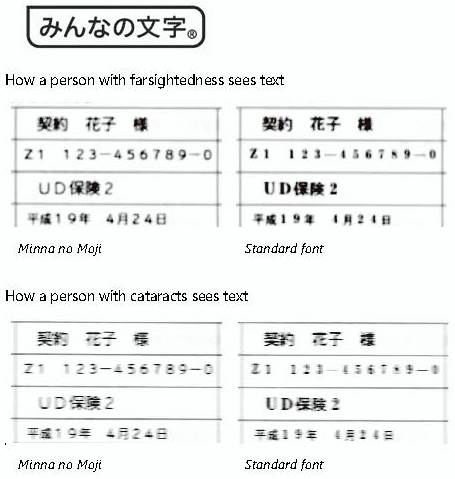
The first thing they considered was why some texts are hard to read. The three major reasons they cited were (1) visual issues on the reader’s side, including age-related impairments or cataracts and fatigue; (2) poor reading environment, such as low lighting or reduced contrast; and (3) loss of clarity when enlarged or shrunk during photocopying, such as text becoming too faint or thick and loss of space between the letters. The team prepared various fonts to deal with these issues, staging a large number of experiments with trial subjects to determine which letters, words, and passages were the easiest to read. They examined exactly the qualities that make text more readable, and the result was a high legibility font called Minna no Moji.
Today, the font is used in a variety of corporate documents, such as operating manuals and contracts for financial products.
Meeting “Everyone’s” Communication Needs
The Mina no Moji project enabled Dentsu to provide a practical solution to a real social problem. The company also gained insights into the efforts required to create a society in which diversity is fully acknowledged and respected.
Employees involved in the project wondered whether there are not many other communication issues waiting to be solved through similar initiatives and expressed a wish to continue working to meet such needs. The result was the establishment of an expanded, companywide team that today has become Dentsu Diversity Lab.
DDL began addressing the needs of people with hearing impediments. While hearing aids are used by many people in the United States and Europe in their sixties, these devices are often not worn in Japan until people reach their seventies, when their hearing has already become quite poor. Many people who could benefit from wearing hearing aids do not use them, the result being that some cannot hear what they want to hear, and the people to whom they are talking cannot fully convey what they wish to communicate.
This is thus a social issue. At the same time, it is also a business issue, not just for manufacturers of hearing devices but also for communication specialists, whose message may not be reaching their audiences as effectively as they had assumed. From the perspective of the advertising industry, there may be a sizable number of people unable to understand the information aired during a 15-second TV commercial. Recognizing and respecting diversity is a popular CSR theme, but it is also much more; there is a need to accurately ascertain who people with special communication needs are and how large a share they make up in society.
The answers DDL came up with are shown in Figure 1. These are the people in Japan who might require special attention in meeting their communication needs. Visual and hearing disabilities can impede reading and the ability to converse, as can physical disabilities. For sexual minorities (lesbian, gay, bisexual, and transgender), misunderstanding and prejudice can become a barrier to communication. DDL discovered that 16.9 million people, or 13% of the Japanese population, fall into one or more of these categories. Elderly people may also be classified as having special needs as they develop various physical impairments and grow frail. If people 65 and older are included in the total, the targets of diversity initiatives would account for some 36% of the population.
The figure does not include children, those with minor impairments, or those afflicted by chronic illness, so there may be a much larger pool of people with special communication needs in Japan.
DDL believes that creating a society that respects diversity means considering the needs of these groups. Inasmuch as this group comprises at least 36% of the population, DDL refers to them as minna (everyone).
Figure 1. “Everyone” (People with Special Communication Needs) Includes . . .
(1,000 people)
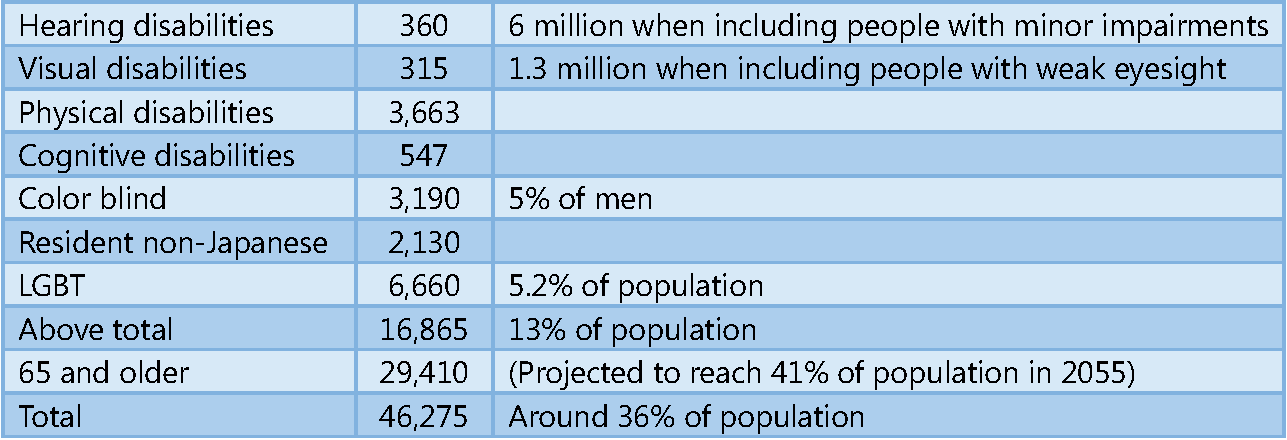
Source: Dentsu Diversity Lab.
If one in three people in Japan belongs to this group, then they are already all around us, among friends and family; in fact, we may be among the “special” ones ourselves. So the problems that affect minna really do concern “everyone” in society. Rather than seeing differences in terms of better or worse, respecting diversity should mean construing divergent needs as expressions of individuality and regarding their problems as our own. This is the approach embraced by DDL: to identify social issues—starting with communication—and find solutions to them.
“Diversity Thinking”
As the word suggests, diversity means thinking about people with divergent needs, including among those who share the same disability. This is why DDL began its activities by engaging in “diversity thinking.”
Diversity thinking lies at the heart of all initiatives directed at addressing people’s special needs. Without a full understanding of what diversity really is, there is little point in measures that, on the surface, appears to address this issues, whether in how we work or how we operate a business. They will simply be ego-gratifying exercises that do nothing to solve real issues affecting “everyone.”
For example, consider a situation that takes place in a suburban restaurant, the sort of place where one would go to eat something special: the price may be a bit high, but it has a good reputation—a trendy restaurant for which you would want to dress up a little.
Now imagine that a family of four arrives, including a person in a wheelchair. You greet the group as the head waiter and, taking note of the wheelchair, suggest a table for four by the window, which gets plenty of sun and should be perfect for the family. You turn to instruct the waiting staff to remove the chair next to the window to make room for the wheelchair. Thanks to your quick thinking, the family of four has a very pleasant dining experience.
Now this, at first glance, appears to be a perfect example of respect for diversity, but is it really? You have gone out of your way to accommodate someone with a physical disability so that the entire family can have an enjoyable meal. But this may not be what the person in the wheelchair actually wanted.
Figure 2. Keywords in Creating a Future for “Everyone”
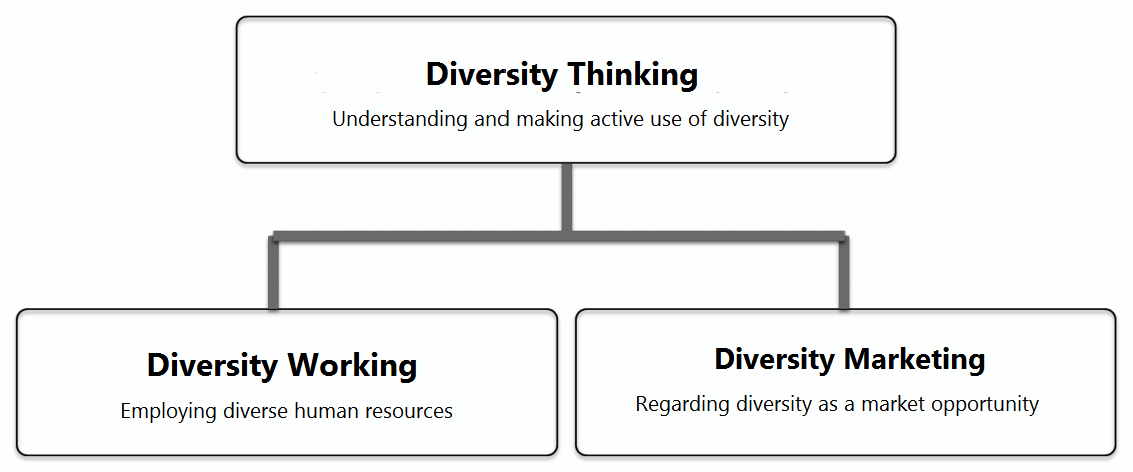
Some wheelchair users might prefer to sit in the same chairs as other diners. The table might be too high, making it difficult to eat while seated in a wheelchair. Or they might prefer not to draw attention to themselves. You have done what you can to provide the best service possible. What could you have done differently?
For one thing, you could have asked what their preferences were. After explaining that there is a nice table by the window, you could have asked the wheelchair user if they would like to use the same chairs as everyone else or sit in their wheelchair at the table.
A failure to ask is not likely to earn any rebukes; after all, you were merely trying to be helpful. But the irony is that many of the things we unthinkingly do, assuming that they would be appreciated, may not necessarily be what is desired.
So, what can we do for people with disabilities? The answer is to talk to them and ask what they really want. This might sound obvious, but in practice it is rarely done, for most of us simply do—and keep doing—what we think is best based on past experience.
Diversity thinking can thus lead to changes in our basic attitudes toward how we work or run a business. The restaurant in the above example may have gained some very enthusiastic and loyal new customers if it had simply confirmed the wishes of a person with a disability.
Another manifestation of diversity thinking at DDL is Minna no Kaigi (Conferences for “Everyone”), organized in conjunction with the Accessible Design Foundation of Japan to encourage the application of this thinking toward Dentsu’s customers, products, and solutions.
Steps and other height differentials, for example, are a hindrance for wheelchair users; accessibility would be greatly enhanced if there were no steps at all. But for the visually impaired who rely on white canes to get around, physical obstacles provide much needed guidance. While steps cause problems for some, they are essential for others. At first glance, a compromise may appear impossible. But during a Minna no Kaigi conference, people with different disabilities can sit down together to learn about each other’s needs and wishes and suggest ways to meet many different requirements (Figure 2).
Figure 3. Issues Addressed by Minna no Kaigi
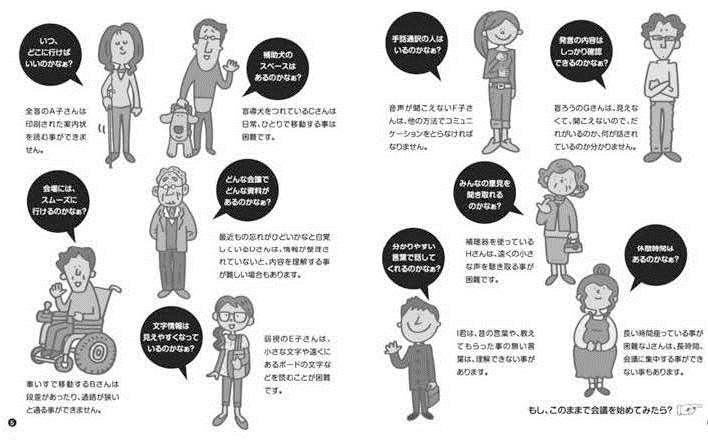
The LGBT Survey and “Diversity Marketing ”
When Dentsu Diversity Lab was launched, a hundred employees expressed an interest in taking part, many of whom considered themselves to be among the group of “everyone” requiring some special attention as a result of having a disability, non-Japanese nationality, or for other reasons. They no doubt believed that DDL would offer them a chance to do something for society and to put their own personal perspectives and experiences to use, as well as to reexamine their role in the company.
DDL was subdivided into four working groups focusing on disabilities (physical, mental, emotional, etc.), gender (gender equality, LGBT, etc.), multicultural issues (nationality, culture, ethnicity, religion, etc.), and generational issues (senior citizens, children, intergenerational disparities). While specific approaches varied according to the theme addressed, the core value driving all groups was diversity thinking.
But for some topics a shortage of material made even this first step difficult, one of them being LGBT (lesbian, gay, bisexual, and transgender)—an umbrella term for sexual minorities (Figure 4).
Figure 4. Varieties of Sexual Minorities

Source: Dentsu Diversity Lab.
The considerable media exposure enjoyed by onee gay celebrities in Japan suggest that Japanese society is open to LGBT people, but in fact a majority do not disclose their sexual orientation due to fear of discrimination and prejudice. Russia recently passed a law that could encourage discrimination against gay people, leading to several Western heads of state boycotting the opening ceremony of the Winter Olympic Games in Sochi. There is a now a civil rights movement centered on the United States and Europe to secure human rights for LGBTs, and in 2011 the United Nations Human Rights Council adopted a resolution protecting their human rights. The LGBT market is estimated to be around 77 trillion in the United States and 7 trillion in Britain.
Since many people conceal their sexual orientation due to fear of discrimination, the actual number LGBT people in Japan cannot be easily ascertained. With the help of specialists, DDL thus conducted fact-finding research of various LGBT groups.
In February 2012 the Dentsu Innovation Institute conducted an Internet survey of 70,000 people to gain an idea of the number of LGBT people in Japan and to shed light on their preferences, attitudes, and behavior.
The survey revealed that of the 70,000 respondents, 5.2% fell into one of the LGBT categories—that is, 1 in 20 people. Around 10%, moreover, said that they personally knew of an LGBT person. These findings showed Dentsu that the LGBT issue cannot be ignored, either from its perspective as an employer or in terms of the potential LGBT market.
Dentsu has revised its stance and has become more supportive, adding a clause to the Dentsu Group Code of Conduct to end all discriminatory practices toward LGBT people and making changes to work styles and office layouts. It has also produced an easy-to-read pamphlet with frequently asked questions and answers to eliminate discrimination and prejudice.
These efforts have not just helped protect the human rights of Dentsu employees but also led to requests to organize human rights workshops from client companies. Dentsu is also looking to tap the sizable the LGBT market, encouraging companies to include same-sex couples as targets of their family-oriented products and services. Dentsu is thus promoting diversity not just as part of CSR but also because it sees market and business potential there.
Working with Outside Experts
Dentsu treats “everyone” else with special communication needs in the same way Many companies already offer various solutions for people with visual and hearing disabilities—quite unlike the situation faced by LGBTs, whose very presence had largely been invisible. Yet, those solutions have not always met their needs. The DDL disability team thus chose to apply diversity thinking and seek the cooperation of outside companies with expertise in these areas.
One example is Uni-Voice. People with visual disabilities are either unable to read text or have great difficulty doing so. This might not be a problem when they want to access the news or read notifications from the local government office, since they can either ask someone to read it out loud or obtain the information through braille.
But there are other times when the text includes private information, such as bank balances or pension statements. Sharing such information may make both the reader and listener uncomfortable and could even lead to unwanted worries and doubts about not being told the truth or being deceived.
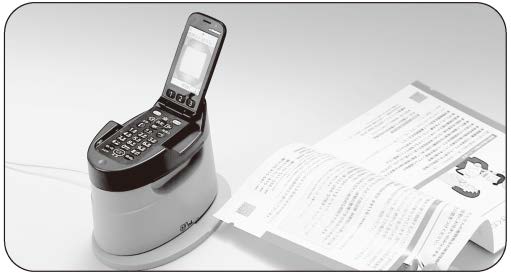
Uni-Voice is a technology developed by JAVIS (Japan Association for the Visually-impaired Information Support) that can turn text into an audio message with the use of a smartphone or cellphone. It converts up to 800 characters of text into a two-dimensional barcode, which can then be “read” aloud by a phone by using the phone’s camera. DDL chose to work with JAVIS to expand the use of this technology to meet specific social needs.
For people with visual impairments, Uni-Voice offers a way of accessing written information that they would prefer to keep private. This system was first used for pension statements and is now being extended to tax payment slips and bank balance statements. Its use is also being promoted in pharmacies to ensure that information about medication and medical expenses are conveyed accurately.
An added feature is a translation function, which enables users to have the information contained in the scanned barcode read out in English, Chinese, or Korean. Such a function may be quite useful for tourists during the 2020 Tokyo Olympics and Paralympics, as well as for confirming one’s bank balance and obtaining pharmaceutical information.
Integration with Main Business Operations
The mission of DDL is to draw on Dentsu’s communication expertise to promote diversity in the workplace and in society, eliminating prejudice, shedding light on “everyone’s” various needs, and making diversity a fact of life. The biggest challenge it faces may be to synergistically integrate DDL’s initiatives and Dentsu’s main business operations. From the company’s perspective, there must be tangible results to match the money it spends.
DDL members express a wish to more fully integrate its activities with the company’s operations, precisely because the work it does has value for society. Dentsu is a communications specialist, so diversity is a field that could easily lead to new business opportunities.
Some DDL participants may be satisfied doing pro bono work in their field of expertise, contributing something to society without seeking anything in return. But it is often by integrating such activities with business operations that the solutions offered can be made to conform to the exacting, professional standards society demands. A serious business approach can abet the development of truly effective solutions.
Dentsu is fully aware of the merits of integration and endorses DDL’s activities and employee participation precisely for this reason. It sees DDL as not only contributing to the solution of social issues but also enriching its own value chain. The ideas, frameworks, and solutions developed through DDL are actively being applied in Dentsu’s business operations, helping the company to enhance diversity-oriented R&D and marketing at the top of the value chain.
